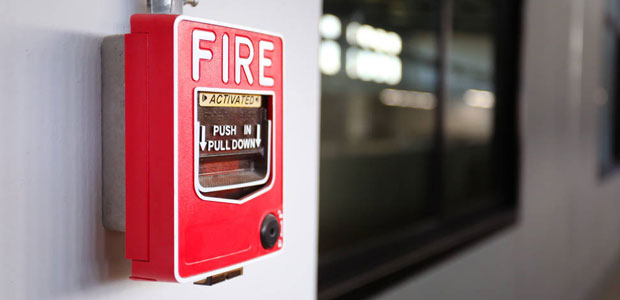Table of Contents
When it comes to fire safety in buildings, fire alarm systems play a critical role. These complex systems work in tandem to identify and respond to fires, helping to minimize the damage caused by fires and ensure the safety of building occupants. In this article, we’ll look closely at how fire alarm systems work and why they’re essential for maintaining fire safety in facilities.
01
of 05
Types of Fire Alarm Systems
There are several different types of fire alarm systems, each designed to meet specific needs and requirements. The most common types of fire alarm systems include:
Conventional Fire Alarm Systems
Conventional fire alarm systems are the most basic type of fire safety system. They are designed for smaller buildings with simple fire safety requirements and for monitoring fire sprinkler systems. These systems work by continuously monitoring the resistance of the circuit from the Initiating device to the control panel.
How do conventional systems work?
A conventional fire alarm system works by continuously monitoring the resistance of a circuit, from the detector to the panel. Conventional detectors typically have a sensing element with a normally closed switch, creating a complete circuit. When a fire is detected, the sensing element opens the switch, causing the circuit to break and alerting the control panel. The control panel then activates the alarm to warn building occupants of the fire.
Addressable Fire Alarm Systems
Addressable fire alarm systems are more sophisticated than conventional systems and are typically used in larger buildings or multi-occupancy structures. These systems assign a unique address to each fire detector, including smoke, carbon, and heat detectors.
Advantages of Addressable Fire Alarm Systems
One of the key advantages of addressable fire alarm systems is the ability to specify the location of a fire or event. Unlike conventional systems, which only monitor the resistance of a circuit, addressable systems can provide valuable information about the specific location of a fire, allowing for a more targeted response.
02
of 05
Components of a Fire Alarm System
A fire alarm system is comprised of several key components, including:
Control Panel
The fire alarm control panel (FACP) is the brain of the operation. It receives signals from the initiation devices and triggers the appropriate response, such as sending a supervisory signal when carbon monoxide is detected or activate the notification devices to start an evacuation in the event smoke or heat is detected.
Initiating Devices
Initiating devices detect the presence of whatever it was designed to and triggers the system. There are several types of Initiation devices, including smoke, heat, carbon monoxide, flame detectors, manual pull stations, a fire sprinklers flow switch, and more.
Notification Devices
Notification devices are devices that alert building occupants of a fire. These can include audible alarms, such as bells, horns or sirens, and visual alarms, such as strobing lights.
Fire Suppression Systems
Fire suppression systems are designed to suppress or extinguish fires. They can come in various forms, such as sprinklers, clean agent, dry chemical systems, and more. Often monitored and controlled by a fire alarm system.
Central Monitoring Station
Some fire alarm systems are connected to a central monitoring station. This station is staffed by professionals who monitor the fire alarm systems of multiple buildings and respond to alarms as needed. When a fire alarm is triggered in a building, the signal is transmitted to the Central Monitoring Station, which then dispatches the fire department and notifies building occupants or owners if necessary.
03
of 05
How Fire Alarm Systems Work
Fire alarm systems work by detecting a fire and triggering the appropriate response. When a fire is detected, the control panel receives signals from the detectors and triggers the alarm, activating the fire suppression system if necessary. If the fire alarm system is connected to a central monitoring station, professional staff are also notified and can respond to the alarm by dispatching the fire department and notifying building occupants or owners.
04
of 05
Benefits of Installing a Fire Alarm System
Fire alarm systems provide several key benefits to building owners and occupants, including:
Early Detection
One of the primary benefits of fire alarm systems is early detection. These systems are designed to detect fires quickly and trigger an alarm, allowing for a rapid response and potentially saving lives and reducing property damage.
Alerting Occupants
In the event of a fire, fire alarm systems are designed to alert building occupants and allow them to evacuate the building safely. This is particularly important in multi-occupancy buildings or those with a large number of occupants.
Triggering Fire Suppression Systems
When a fire is detected, fire alarm systems can also trigger fire suppression systems such as sprinklers, which can help to extinguish the fire and minimize damage to the building and its contents.
Compliance with Fire Safety Regulations
Many cities and states have fire safety regulations that require buildings to have fire alarm systems installed. Ensuring compliance with these regulations is an important aspect of maintaining fire safety, meeting legal obligations, and increasing tenant satisfaction.
05
of 05
Conclusion
In conclusion, fire alarm systems are essential in maintaining fire safety in buildings. They provide early detection, alert building occupants, trigger fire suppression systems, and facilitate a safe evacuation. Building owners and managers should ensure that their buildings have a fire alarm system installed and that it is regularly inspected and maintained to ensure it is in good working order. By doing so, they can meet their legal obligations, meet insurance requirements, and increase tenant satisfaction.














